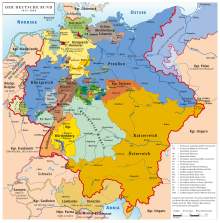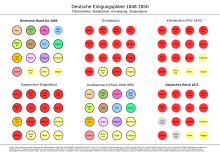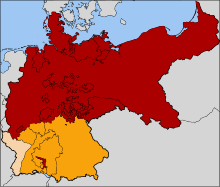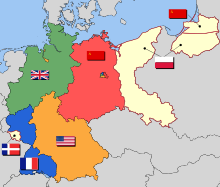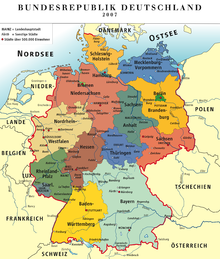German question
The German question (alternative spelling: German question ) or Germany question in the narrower sense describes the problem complex of German unity which has not been resolved in European history between 1806 and 1990 and which recurs in various forms . It revolved around the borders and territorial order of Germany . With reunification in 1990, the German question is now considered to be resolved, especially since Germany is a member of the United Nations and the European Union with equal rights with other states . In a broader sense, the German question has been the question asked since the late Middle Ages , how the central country in the middle of Europe with the best facilities for prosperity and a dominant position on the continent can be contained and controlled for the benefit of the other (European) powers. This article confines itself to the question in the strict sense.
Origin of the German Question after the Collapse of the Old Empire (1806)
As the eastern legacy of Charlemagne's Frankish Empire, an empire emerged in the 10th century that, as the Holy Roman Empire , challenged the conflict with the successor to the Roman Empire, the Byzantine Empire . Later, after the loss of the Burgundian territories as well as large parts of imperial Italy , the suffix German Nation was added to the imperial title. In this formerly tribal alliance kingdom of kingdoms and principalities in the Middle Ages, different peoples lived, from whose language German developed , among other things .
In the 18th century, the Prussian-Austrian dualism emerged in the empire, which led to armed conflicts between these two powers (including the Seven Years' War ). The power of the Holy Roman Emperor Francis II. On the now also states to be named the Estates was, however, still lower, and these then came after the Peace of Luneville (1801) and the Reichsdeputationshauptschluss (1803), more and more under the influence of Napoleonic France .
When the Austro-German "double emperor" Franz II had to lay down the imperial crown under pressure from Napoleon and 16 southern and west German imperial estates seceded from the empire in 1806 in order to form the German Rhine Confederation , which was protected by Napoleon, the empire fell apart (" Franzosenzeit " ), although the Habsburg Franz II remained as Emperor Franz I of the Austrian Empire, which he founded in 1804 .
With the resignation of the Roman-German imperial crown in 1806, the "German question" began in the true sense.
Creation of a German nation-state (1813–1871)
Wars of Liberation (1813-1815)
With the beginning of the wars of liberation against France, what was then Prussia became the first German state to raise the “German question”. His royal house, the Hohenzollern , now demanded the re-establishment of the German Empire. Many Germans followed this main demand until 1815, while it was rejected by the other ruling houses in Germany.
The German nobility was indignant on for his stand catastrophic results of the French Revolution , the political aspiration than to "national unity" in many European countries found followers. The influence resulting from France's pioneering role was not able to flourish in Germany, which had only just freed itself from Napoleon, and the mood turned into undisguised revanchism towards France.
German Confederation (1815–1866)

This map, from the time of the earliest German studies, has many historical features. So u. a. Swedish and Danish are subordinate to the German language, English appears to be unrelated and Dutch , Frisian and “ Sassian ” are represented collectively as the “Low German language strain ”.

With the establishment of the German Confederation on June 8, 1815 at the Congress of Vienna , the German question appeared to be closed from the outside. But the liberal and nationally minded bourgeoisie was not satisfied with a loose union of the German royal houses and demanded a unified German Empire, a federal state .
In 1848/49, as a result of the March Revolution, there were uprisings in the German Confederation. The German question was also back on the agenda. After the election of a German National Assembly as the all-German parliament , the German Confederation should now, in the opinion of the German Nationals, be converted into a German Reich. The main question was whether the “ Greater German solution ” or rather the “ Small German solution ” should be implemented. With the former, power would have remained with the Catholic South under the leadership of Austria, with the latter it would have fallen to the Protestant North under the leadership of Prussia. With the Olomouc puncture of 1850, the German Confederation was restored under the leadership of Austria, and Prussia had to give up its attempt to establish a national state, the Erfurt Union .
After a Prussian defeat in the vote on federal execution due to the dispute over the administration of Schleswig-Holstein and the mobilization of the federal army , the German war broke out in 1866 on the question of supremacy in the German Confederation between Austria and Prussia .
North German Confederation and Forging an Empire (1867–1871)
After the Prussian victory in the Battle of Königgrätz in 1866, the German Confederation was dissolved and Austria turned more to its non-German-speaking areas in Southeast and Eastern Europe . With that the German question was settled at least for Austria, the Austrian Empire was converted into the dual monarchy Austria-Hungary . In contrast, many of the remaining states of the German Confederation were united in the Prussian- dominated North German Confederation .
At the end of another armed conflict, the Franco-German War , the unification of the empire took place in 1871 . Otto von Bismarck convinced the southern German states to join, so that the founding of the German Empire as the first unified nation state could be ceremonially celebrated: The Empire was proclaimed with the proclamation of Wilhelm I as German Emperor on January 18, 1871 in the Palace of Versailles .
This so-called small German solution , which came about without Austria, was not the ideal situation for the German national movement, but from the point of view of Prussia and Bismarck it was the preferred one for political reasons.
Maximum demands, such as those of the Pan-German Association , which even called for the connection of former Roman-German imperial areas such as the Netherlands , Belgium and the Swiss Confederation , were not heard after the establishment of the empire.
The German question was considered settled after the unification of the Germans in the German Reich.
Loss of territory and annexations (1918–1945)
After the First World War and the Weimar Republic (1918–1933)
After the end of the First World War and the subsequent collapse of the monarchies in Germany and Austria, the German question arose again in German-speaking countries in 1918/19. It showed that this had largely survived among the people .
The German-speaking areas of the Austrian half of the disintegrating multi-ethnic state Austria-Hungary merged to form German Austria at the end of October 1918 . On November 12, 1918, the Provisional National Assembly resolved the republic as a form of government and that German Austria was part of the German Republic ; as a result, expert discussions began on integration. Vorarlberg decided in a referendum in 1919 to join Switzerland , which the Confederates rejected. The intention to join Germany or Switzerland was, in addition to aspects of self-determination, also due to the fact that many believed that Austria, which would in future be reduced by important industrial and raw material areas, was not economically viable .
With the unification of these two states, the German question would have been "finally" resolved in the sense of many contemporaries. But with the unification of almost 73 million inhabitants, such a Greater Germany would have become one of the most powerful states in Europe. The unification was prevented by the victorious powers: In the Treaty of Saint-Germain 1919 German Austria is only referred to as the Republic of Austria and the legal or economic union with Germany is excluded. In 1920 the first Austrian federal constitution was passed. The German question remained open; the Social Democratic Labor Party (SDAP) kept z. B. the wish to join in their party program until 1933.
In 1932 the German Reich and Austria tried to establish an economic union - this was also prohibited by the League of Nations .
Period from National Socialism to the War (1933–1939)
With the coming to power of the Nazis , the German question was revived propaganda and instrument and bearer of a destructive and aggressive expansion policy: Even the "party program of the NSDAP " - Adolf Hitler's famous " 25-point speech " of 1920 - began with the words:
"First: We demand the unification of all Germans on the basis of the peoples' right to self-determination to form a Greater Germany."
On March 12, 1938, German troops marched into neighboring Austria ( "Anschluss" to the German Reich ). The Wehrmacht troops came after the forced resignation of ultimatums by the Austrian government under Kurt Schuschnigg only little resistance and were in many places even welcomed by the people of Austria. The Nazi propaganda coined the standing sentence: “One people, one Reich, one Führer!” However, people had primarily expected a better life in Austria as a result of the Anschluss, especially due to the high unemployment . But the Nazi regime immediately let its oppressive apparatus rage also in Austria, which was initially officially renamed "Ostmark" in order to erase its national identity, but later only referred to as the Danube and Alpine Reichsgaue . In the first days after coming to power, the new rulers arrested around 72,000 people, especially in Vienna, including many politicians and intellectuals from the First Republic of Austria. The police, who were immediately subordinated to Heinrich Himmler , suppressed any sustained resistance. At the Brenner, German and Italian troop units finally met for friendly ceremonies after Benito Mussolini had given up his protective role for Austria due to other political considerations. As a result, the German-speaking Sudetenland and the Memelland were incorporated into the Reich.
Second World War (1939–1945)
During the Second World War , Danzig (formerly Free City of Danzig ) and the Polish Corridor were incorporated into the Reich and in 1940 the French Alsace-Lorraine and the Belgian region of Eupen-Malmedy were annexed.
In 1943, the German area of power reached its greatest extent when South Tyrol was placed under German civil administration: With the exception of the predominantly Danish-speaking North Schleswig , German-speaking Switzerland and Liechtenstein , the entire German-speaking area was united in the Greater German Reich - it now comprised around 650,000 km². By this time the German question had long since been reinterpreted as self-exaltation, the dark background of which was the " creation of living space " through the war of annihilation in Eastern Europe.
The later Federal President of Austria, Adolf Schärf, reports in his memoirs that in 1943 he was visited by representatives of the German Social Democrats in Vienna who wanted to talk about the state to be established after Hitler's defeat. At that time, Schärf replied spontaneously and to the amazement of other Austrian social democrats that love for Germany had been driven out of the Austrians and that a common state was no longer an option.
The fact that Austria was designated by the Allies in the Moscow Declaration of 1943 as “Hitler's first victim” (which was one of the founding elements of the victim myth in Austria) and that the Allies wanted to establish an independent Austria - as after the First World War - made it easier for the people from 1945 not to be regarded as an accomplice of National Socialism for decades and from the 1950s to increasingly cultivate an Austrian identity .
German division (1945–1990)
Post-war period and two states (1945 to 1980s)
With the unconditional surrender of the Wehrmacht , the overthrow and the complete institutional collapse of National Socialist Germany as well as the division into zones of occupation and the subordination of the German eastern territories within the Reich borders in 1937 to largely Polish administration , the German question arose again in 1945. For the Allies, the division and occupation of Germany was connected with the security issue, security against a new German aggression.
As early as February 1945, the Soviet Union had illegally placed the eastern territories of the German Reich conquered by the Red Army under the administration of the People's Republic of Poland as a replacement for the eastern Polish territories it had annexed . This drove out the German population from there until 1950. This resulted in serious changes in territorial and constitutional law, which in large parts of the German population in the three western occupation zones of Germany and from 1949 onwards by most of the German politicians as "trisection of Germany", which they rejected. According to the threefold thesis, the Soviet occupation zone and the GDR were called "Central Germany" for a long time, while the area east of the Oder and Lusatian Neisse was called "East Germany" .
Austria, which was occupied in 1938 and then fully integrated into the Reich, was reestablished in 1945 as an independent state within the borders of 1938, making it a foreign country for Germany . The cities of Vienna and Berlin were governed as four-sector cities , the state of Prussia, the largest part of the German Empire, was abolished by the Control Council Act No. 46 .
With the establishment of the Federal Republic of Germany , which was still subject to the occupation statute and did not receive full sovereignty, and the establishment of the German Democratic Republic (GDR), the German question became more complicated from 1949. From the West German point of view, there was an additional security question: who would ensure the security of the Federal Republic in the event of Soviet aggression? In March 1951 the Allies granted the Federal Republic of Germany its own Foreign Ministry , which the Federal Chancellor Konrad Adenauer took over himself.
Since the 1960s, the GDR increasingly emphasized the two-state theory , in 1974 definitely gave up reunification as a state goal and spoke of "former German areas" in Poland and the Soviet Union. The Federal Republic of Germany stuck to its commitment to the whole of Germany , which was formulated in the preamble and in Articles 23 and 146 of the Basic Law , and for a long time raised a claim to sole representation , which also included the " Zone " (GDR) and "German areas under temporary Polish or Soviet administration ”included. With the increasingly solidifying systemic contrast, the hope of a practical implementation became a long way off, until finally it was more about lip service and vague hopes than actual practical guidelines for action.
In West Germany , the new Ostpolitik and finally the basic treaty between the Federal Republic and the GDR in the 1970s created the conditions for German-German contacts on a political level, which led to a policy of détente on both sides. The Oder-Neisse Line was accepted as the eastern border of Germany in the Warsaw Treaty of 1970 , thus giving up the claim to about a quarter of Germany's pre-war territory that had been maintained since the end of the war. The existence of two states on the soil of Germany was seen as in fact unchangeable. In 1987, Federal President Richard von Weizsäcker replied to the General Secretary of the CPSU , Mikhail Gorbachev , who at the time did not want to know anything about an "open German question": "The German question is open as long as the Brandenburg Gate is closed."
Turning point (1989–1990)
The opening up of Eastern Europe and the rapid decline of SED rule in the GDR surprised all West German experts and politicians. There was no plan for such a case.
In large parts of the West German public, calls for an unification of the two German states were viewed as reactionary , although the reunification requirement was upheld. The federal government made up of CDU / CSU and FDP officially called for German reunification , but in fact the governing bodies accepted the division of Germany as a reality.
The attitude of the individual politicians was different. While older politicians or those who grew up east of the old Federal Republic, such as Willy Brandt or Hans-Dietrich Genscher, considered German unification worth striving for but politically impracticable, younger (such as Oskar Lafontaine ) felt this vision to be a relic of the past. The attitude of the Allies and especially of the Soviet Union , without whose consent German unity was unthinkable, was largely unclear .
Within the GDR, the opinion on the German question was initially unclear. The ruling SED was strictly against the reunification of Germany, and in autumn 1989 many prominent civil rights activists signed the declaration for our country published on November 28, 1989 , in which they called for an independent, but open and democratic development of the GDR independent of the Federal Republic (more thematic Approach of “ Democratic Awakening ” and “ Democracy Now ” as political organizations).
At the Monday demonstrations , it was not “We are one people” but only “We are the people” that was initially shouted. This appeal demanded from the People's Police not to use force against their own people, and from the government more democracy or at least consideration of the opinion of the people. The West German tabloid with the highest circulation wrote two days after the fall of the Berlin Wall on the development of opinion in the GDR: “'We are the people' they call today - 'We are one people' they call tomorrow!” The call for unity “We are one people” became short Some time later, it was picked up by the West German CDU, printed hundreds of thousands of times on posters and stickers and only documented at the Monday demonstrations from mid-November 1989.
Federal Chancellor Helmut Kohl presented his ten-point plan on November 28, 1989 without consulting coalition partners or allies . This uses the terms “contractual community” and “confederation”, but does not specify them.
After the positive reaction of the Americans and Gorbachev's approval on 10/11. February 1990 (lightning visit by Kohl and Foreign Minister Genscher in Moscow) for the unification of Germany, the CDU / CSU and FDP began to demand German unity more and more openly. Since the Volkskammer election in 1990 at the latest , the unification of the old federal states with the new ones was considered certain; the question now posed was no longer if, but when a united Germany would arise again.
Accession negotiations began, which were concluded with the accession of the GDR countries to the Federal Republic of Germany (→ Unification Treaty ). The actual process and the time of reunification on October 3, 1990 (“ Day of German Unity ”) were determined less by the negotiating sides than by the acting population. The slogan "If the D-Mark comes, let's stay, if it doesn't come, let's go to her!" Was intended as a consideration of another massive escape from the GDR . The introduction of the D-Mark as the official currency on July 1, 1990 was a big step towards German unity. This historic success is also to be seen as the reason for the tolerance of these processes by the victorious powers and the international community.
The two plus four treaty concluded between the two states in Germany on the one hand and the four powers on the other hand does not count as a peace treaty under international law , but it has such a character. The accompanying German-Polish border treaty - based on the Görlitz Agreement (1950) and the Warsaw Treaty (1970) - established the Oder-Neisse border as “inviolable”, and Germany confirmed it when it came into force in 1992, on territorial claims since then renounce former German eastern territories . The Federal Republic of Germany has recognized the "finality of the borders as an essential part of the European peace order" (quote from the final declaration).
The Article 23 Basic Law (due to the joining area of so-called "Accession Article") has been deleted and after the reunion as a purpose "through the so-called articles Europe replaced" preamble and Article 146 GG were changed. With the fulfillment of the reunification mandate to “complete the unity and freedom of Germany”, the formation of the nation state in Germany was completed for the German federal government, but also for the general public. Since then, the German question has been finally resolved under constitutional , political and international law .
See also
- Legal position in Germany after 1945
- Chronicle of the division of Germany
- Berlin question
- History of Germany
literature
- Albrecht Behmel : The Central European Debate in the Federal Republic of Germany: Between Peace Movement, Cultural Identity and the German Question . Ibidem-Verlag, Hannover 2011.
- Dieter Blumenwitz : I think of Germany. Answers to the German question. Bavarian State Center for Political Education , Munich 1989, 3 parts (2 volumes, 1 map part).
- Anselm Doering-Manteuffel : The German Question and the European State System 1815–1871 , 3rd, to a post. Ed., Oldenbourg Wissenschaftsverlag, Munich 2010, ISBN 978-3-486-59675-5 ( Encyclopedia of German History , 15).
- Lothar Gall : Bismarck, Prussia and national unification , in: Historische Zeitschrift 285 (2007), pp. 355–371.
- Gerd Langguth (Ed.): The intellectuals and the national question , Campus Verlag, Frankfurt am Main 1997, ISBN 3-593-35725-9 .
- Nicolas Lewkowicz: The German Question and the International Order, 1943–48 , Palgrave Macmillan, Basingstoke / New York 2010, ISBN 978-0-230-24812-0 .
- Nicolas Lewkowicz: The German Question and the Origins of the Cold War , IPOC, Milan 2008, ISBN 978-88-951452-7-3 .
- Alexander Muschik: The two German states and the neutral Sweden. A triangular relationship in the shadow of the open question in Germany 1949–1972. Münster 2005, ISBN 3-8258-9044-9 .
- Peter Steinhoff: Prussia and the German Question, 1848–1850 , dissertation.de, Berlin 1999, ISBN 3-933342-98-8 .
- Wilhelm Wengler : Writings on the German Question: 1948–1986 . Edited by Gottfried Zieger. Walter de Gruyter, Berlin [a. a.] 1987, ISBN 3-11-011100-4 .
-
Heinrich August Winkler : The long way to the west . CH Beck, Munich 2000.
- Volume 1: German history from the end of the Old Reich to the fall of the Weimar Republic. ISBN 978-3-406-46001-2 .
- Volume 2: German history from the “Third Reich” to reunification. ISBN 978-3-406-46002-9 .
Web links
- Wilhelm Bleek, Christian Bala: The national idea in the two German states ( Memento from October 19, 2012 in the Internet Archive ), in: Andersen, Uwe / Wichard Woyke (Ed.): Concise dictionary of the political system of the Federal Republic of Germany. 5th, updated Ed., Leske + Budrich, Opladen 2003. Licensed edition Bonn: Federal Agency for Civic Education 2003.
- Dialectic of self-delusions , time online
- Alexander Gallus: Ideas of a Pax Germanica after 1990 - reflections on the legacy of the “third way” in Germany politics ( Memento from August 3, 2009 in the Internet Archive )
- Political science literature on the topic of the German Question and Peaceful Revolution in the Annotated Bibliography of Political Science
Remarks
-
↑ This language map from 1880 shows the names of the states “Netherlands” and “Belgium” and the words “Vlämingen” in northern Belgium, but any reference to the linguistic independence of these areas was avoided.
In accordance with the nationalistic zeitgeist prevailing in the German Reich at the time (cf. with reference to the Dutch Ulrike Kloos: Dutch image and German German studies 1800–1933: A contribution to comparative imagology , Studia imagologica 04; Rodopi, Amsterdam 1992, pp. 12–13 , 98 ff., 128 ff.), Languages and peoples were generally equated and therefore peoples were depicted instead of languages (cf. Ulrike Kloss, op. Cit., P. 77). The inhabitants of the Netherlands and Northern Belgium were declared "Low German" because their language was supposedly the same as in Northern Germany. - In the first edition of Karl Bernhardis Sprachkarte von Deutschland (1844), the content of which is comparable, the German language was included in accordance with Jacob Grimm's usage (cf. Ulrike Kloss, op. Cit., P. 18 ff.) Equated with the Germanic languages as a whole and differentiated into three "language strains": the High German language strain, the Low German language strain and the Nordic language strain. - In Heinrich Kiepert's Völker [-] and languages map of Germany and the neighboring countries (1872) peoples were depicted instead of languages and the Germans were divided into Upper German, Central German and Low German "tribes". Within the Low German tribes, a "Lower Saxony" tribe "with written High German" was also set off in color from a "Flemish-Dutch" trunk "with dialect written language". See The Maps of Heinrich Kiepert , Ethnology, Germany, 1872 . - ↑ Georg Christoph Berger Waldenegg: The great taboo! Historian controversies in Austria after 1945 about the national past , in: Jürgen Elvert, Susanne Krauß (ed.): Historical debates and controversies in the 19th and 20th centuries (= HMRG supplements 46), Franz Steiner Verlag, Stuttgart 2003, p . 143 ff., Here p. 171.
- ↑ For an assessment of international law, see Manfred Zuleeg : The Oder-Neisse border from today's perspective of international law , Zeitschrift für Rechtssppolitik (ZRP), 2nd year, issue 10 (October 1969), pp. 226-231, here p. 226; on the Soviet-Polish border regulation see Manfred Zeidler : End of War in the East. The Red Army and the occupation of Germany east of Oder and Neisse 1944/45. Oldenbourg, Munich 1996, ISBN 3-486-56187-1 , pp. 48-66, on Polish administration pp. 63 f.
- ^ State act on the death of Federal President a. D. Richard von Weizsäcker , Federal President's Office , February 11, 2015. Weizsäcker already uttered this fanatic sentence in a speech at the German Evangelical Church Congress in June 1985, on this Heinrich August Winkler : What Berlin stands for. The contradicting history of the city , in: Kurt Biedenkopf, Dirk Reimers, Armin Rolfink (eds.): Berlin - what is the capital worth to us? Published on behalf of the German National Foundation, Leske + Budrich, Opladen 2003, ISBN 978-3-8100-4054-1 , p. 19.
- ^ DHM change in the east .
- ↑ IMAGE from November 11, 1989; see. also DeutschlandRadio Berlin: “We are one people!” - In search of the origin of a German reputation , November 4, 2004 .
- ↑ See Hans-Ulrich Wehler , Deutsche Gesellschaftgeschichte , Vol. 5: Federal Republic and GDR 1949–1990 , CH Beck, Munich 2008, p. 335 .
- ↑ Instead of all Heinrich August Winkler, The long way to the west, Vol. 2 , Beck, Munich 2000, especially the summary, pp. 640–657.
- ↑ See e.g. B. Christoph Vedder , in: Ingo von Münch , Basic Law Commentary , 3rd edition 1996, Rn. 95 on Art. 116 GG .
